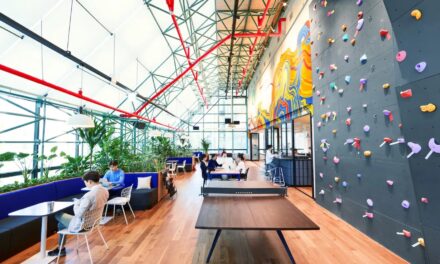Coworking is a popular industry to be in. Plenty of people want the freedom to work remotely but enjoy the companionship of sharing a workspace with others. No wonder the coworking space market is expected to reach $34.99 billion by 2027.
If you run a successful coworking business, chances are you’re considering scaling up. Maybe you want to open a new location in your home city, expand to other states, or even take your business global. But first—you have to know that your growth is on the right track.
So, how do you measure a company’s growth? You need to analyze specific KPIs. In this post, we’ll explore the various growth KPIs and introduce some best practices to elevate your coworking business.
What are growth KPIs?
If KPIs are key performance indicators, growth KPIs are those that relate to a company’s progress. They are quantifiable measurements that help you monitor and track signs of growth in each area of the business.
Business growth means different things to different organizations, and the best indicators of growth will vary between companies. For example, higher profits don’t necessarily equate to sustainable growth. Instead, they could be the result of extensive cost-cutting measures, which could have long-term negative impacts on customer service, leading to customers choosing to go elsewhere.
You may base progress on revenue increasing by a certain amount or attracting a lot more web traffic. For coworking businesses, you’ll be looking at factors such as new membership and retention rates, as well as acquisition costs and conversion metrics.
Growth KPIs help you understand business performance over time and give you a good indication of expected success. You can measure progress towards your aims and use the data to make informed decisions. They’re also useful for sharing with current and potential investors.
7 growth KPIs to elevate your coworking business
There are numerous metrics you can use to evaluate progress, so we’ve picked out 7 of the most relevant KPIs for measuring growth in a coworking business.
– Number of new members
This KPI assesses your ability to attract new members to your coworking space and is an essential KPI if you plan on expanding your business. As well as measuring the number of people who signed up, you also need to look at how many are active users of your services.
It’s also useful to know where your new members have come from. How did they hear about you? What made them want to join? This shows you which marketing methods work best, and you can use the data for future campaigns.
– Website traffic and conversions
An increase in online traffic is a key indicator of growth. As well as your own website, you can look at interactions with your social media channels and Google Business profile. Again, find out where the traffic is coming from and track it with tools such as Google Analytics.
Conversion rate is another essential KPI, providing insight into the success of your online presence. Where do conversions happen? Which CTAs and landing pages work best? Are people bouncing away from the site before converting?

– Member retention and churn rate
It’s important to measure customer growth in terms of new members, but are you retaining those members long-term? Customer retention KPIs reflect satisfaction and loyalty. They help you assess the stability of your revenue.
If users aren’t renewing their membership, why not? How might you make them stay or re-engage those who’ve lapsed? Your churn rate has a huge impact on your growth, so it pays to minimize it as much as possible.
– Average member lifespan
This KPI requires prediction. To forecast continued growth, you need to figure out how many years you can expect each member to stay with your business. This will help you to evaluate the true value of your members in terms of revenue and loyalty.
The catch is that you can’t wait until the end of their lifespan to see how long it actually was—so you have to base it on averages.
– Member satisfaction rate
Monitoring customer satisfaction is critical. If it’s on the increase, this indicates that the company is poised for more growth. Happy members stick around, and they tell others about positive experiences. On the other hand, if this KPI takes a dip, customers may be about to churn.
Send out CSAT or other surveys with open-ended questions. Ask about general satisfaction, and look at how users engage with each other as a community. You can also check the data in your CRM to see details of member interactions and concerns.
– Member acquisition costs
All businesses are aware that it typically costs more to acquire a new customer than to retain an existing one. But it’s important to crunch the numbers and find out exactly how much you spend on elements such as advertising and onboarding.
You can then balance the cost of acquisition against the revenue generated by each member to see how quickly you can expect a positive return on the investment. Try segmenting members to discover if some groups cost more than others.
– Revenue growth rate
KPIs here include the growth rate of revenue per user, as well as the growth of overall revenue. For members, you want this figure to be higher than the amount you spend to keep them. You can measure annual revenue or monthly revenue and segment it by customer type.
A rise in revenue indicates profitability and sustainability, and you can infer that your marketing efforts and engagement strategies are paying off. If revenue isn’t growing, you might want to look at making adjustments before you scale up.
Best practices to improve coworking growth KPIs
Perhaps your growth metrics have revealed that there’s more work to do. In that case, following these best practices can accelerate your progress.
Implement a member-centric approach
You won’t see further growth unless you can keep your members happy. A member-centric approach makes sure that everything is done with them in mind—including a comfortable working environment, a user-friendly website, helpful staff, and optional extra coworking amenities on site.
It’s vital that you ask members for feedback so that you’re aware of what they like and dislike about the business. What improvements or additions do they want to see? Feedback from those who churn is equally important for knowing what not to do.
Becoming more member-centric not only appeals to existing users but also helps you attract new ones. The data you gather is useful for personalization and for letting users know that you value their input.

Foster community building and engagement
A coworking space needs a sense of community to be successful. The whole idea is that remote and hybrid workers can reduce isolation by coming together in a shared space—and take advantage of networking and collaboration opportunities.
It’s important to increase engagement between members and also to encourage members to engage with the business itself—think social media competitions, giveaways, and user-generated content. Create a forum where members can chat and run regular polls and fun quizzes for them.
You might also create a referral program and offer discounts and loyalty schemes for frequent users. On-site or virtual events help bring people together. Beyond the coworking space, consider building relationships with partnerships with local businesses such as food outlets.
Streamline operations and make space for flexibility
If you’re going to offer the best user experience possible, you need to make sure your business processes are super-efficient. It should be easy for people to sign up or reserve a space, while the payment process must also be simple and fast.
Meanwhile, smart tools such as CRMs and time management systems make life easier for your own employees, from HR teams to marketers to on-site staff. A happy and productive workforce usually translates into happier customers.
Flexibility appeals to members, such as adjustable membership plans and the option to book by the hour or the day rather than making a long-term commitment. Offer single occupancy spaces as well as collaborative ones, plus flexible sizes for meeting rooms.
Be strategic in marketing campaigns and partnerships
Your marketing campaigns need to target the right people with the right messages at the right time. Thanks to modern technology, you have a raft of data that can help you do that—from customer records to feedback surveys to web analytics. This is where cloud ERP systems for small business are invaluable, as they bring together data from all areas of the company to help you make accurate predictions and in-depth customer analysis.
It’s important to align marketing activities with strategic objectives. For example, if your main aim is to increase sign-ups, try putting a lead capture tool on your landing pages. Encourage people to book a tour of the premises or input their email addresses to receive your newsletter.
Partnerships are also a great form of marketing. We already mentioned teaming up with other businesses, giving opportunities for cross-promotion. You might also decide to work with affiliate marketers, influencers, or brand ambassadors.
Measure the success of your coworking space with growth KPIs
Measuring growth KPIs is essential if you’re planning to expand your coworking business—or even if you simply want to check on your progress. By monitoring key metrics such as retention rates and customer acquisition costs, you can evaluate performance and make data-driven decisions.
Growth KPIs give you valuable insights into member satisfaction and operational efficiency, helping you to understand where conversions are coming from and where you need to improve. This helps you to reduce customer churn rate and boost the financial health of your business.
Follow our list of KPIs for growth and adhere to the best practices, and you can elevate your coworking business and enjoy long-term success.









